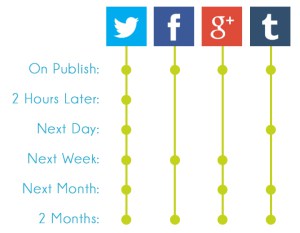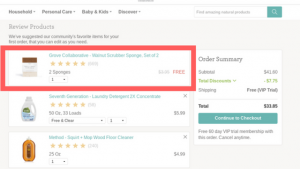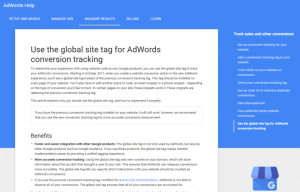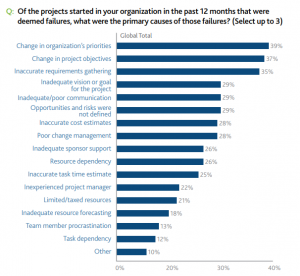
Clients are sometimes surprised to discover my recommendations for how often you should post to social media. They fear they’ll be viewed as spam by their followers. What they’re not realizing is that any single post reaches a small fraction of your audience, regardless of how effectively you time your posts.
lients are sometimes surprised to discover my recommendations for how often you should post to social media. They fear they’ll be viewed as spam by their followers. What they’re not realizing is that any single post reaches a small fraction of your audience, regardless of how effectively you time your posts.
Why you need to post frequently
For most users, posts don’t stay in your wall very long before getting pushed down by newer content.
 With Facebook’s algorithm, posts may NEVER appear on your wall based on the amount of engagement the post garnered previously. If there’s someone you really like to see posts from, add them to your close friends list. I can’t find the cite now, but I remember reading that posts showing up in your newsfeed remain visible for about 14(?) minutes before they get pushed down farther than most users will scroll.
With Facebook’s algorithm, posts may NEVER appear on your wall based on the amount of engagement the post garnered previously. If there’s someone you really like to see posts from, add them to your close friends list. I can’t find the cite now, but I remember reading that posts showing up in your newsfeed remain visible for about 14(?) minutes before they get pushed down farther than most users will scroll.
Twitter will institute a similar algorithm soon, according to rumors. That will reduce the rapid speed with which new content pushes down old content. Again, I can’t find the cite, but it seems to me it suggested a post on Twitter remains for only a few minutes. (BTW, in case you missed the news, Snapchat (where all post are visible, but disappear after you view them) now has more active users that Twitter – something to think about).
As I recall, Pinterest pins had the most staying power of all social networks.
You’re busy, so you don’t look at your Facebook or Twitter all day long. You miss posts.
Why would you think your audience sits there staring at Facebook all day waiting for your posts?
Also, think about where your audience is located. You must reach each audience geographic while these folks are awake. If you’re like me and you’re a global brand, that means publishing posts during the night — I use Buffer and Sprout Social to schedule posts.
Two actions increase the chances your audience will see a post:
- Engagement by friends, which recycles the post at the top of your news feed
- Reposting by the brand
Of course, advertising also increases the chance your audience will see your posts, but limit this discussion to free tools for sharing content.
How often you should post to social media?
The following infographic was crafted by Sumall using data generated by Buffer. It shows that post frequency depends on the social media platform you’re using. It also depends on quality and timing, which we’ll discuss in a moment.
Image courtesy of Sumall and Buffer
Despite these recommendation, which I follow pretty closely with my clients, Buffer ups the ante on some social networks — most notably Twitter, where they post 15 times a day. Even Buffer agrees that sharing more than 1X per hour is going to cost you big time.
Buffer isn’t the only one to recommend how often you should post on social media. Recommendations run the gambit, with some recommending fewer and some recommending more posts/ day.
I would like to point out 2 things about how often to post on social media.
- Be consistent — once you’ve determined how often to post, keep your queue full so you’re consistently sharing content on schedule.
- Don’t fall behind in blog posts, especially. Posting 2X per week is optimal, posting infrequently or inconsistently can damage your SEO and reduce ROI from your website.
My recommendation is to experiment with different sharing schedules to see where engagement begins to drop off.
When it comes to sharing your OWN content, how often should you share?
 Most experts recommend an 80/20 split — that means you share 80% content from other folks and 20% your own content. That means you’re sharing your own content about 1X per day. However, you don’t want to share the same content every day for weeks because it does get pretty spammy.
Most experts recommend an 80/20 split — that means you share 80% content from other folks and 20% your own content. That means you’re sharing your own content about 1X per day. However, you don’t want to share the same content every day for weeks because it does get pretty spammy.
Luckily, Buffer comes through again with a suggested schedule for how often to share a piece of your own content.
I’ve modified this a little and it doubled the traffic to my site without creating any negative effects on other social media. My modification is that I share on Facebook, LinkedIN, and Google+ after 2 weeks rather than 1 week. Because this infographic doesn’t include LinkedIN, which is huge for me, I share to LinkedIN on the same schedule as Facebook.
When should you post?
That’s a $ 1 million question with nearly as many answers.


Guy Kawasaki suggests sharing every 8 hours.
I’ve read recommendations to share on the hour, as that’s when meeting end giving readers a chance to check their social media
I’ve heard it’s better to share on Facebook at 1 and 3 pm on Thursday and Friday; on Twitter on Wednesday, Saturday, and Sunday at 1 pm.
Hubspot suggests the following times: Facebook – 12-1 pm on Sat & Sun, 3-4 on Wed, and 1-4 pm on Thur & Fri; Twitter – 12 -3 pm on Mon – Fri, 5-6 pm on Wed.
Coschedule, which offers the option to schedule at the best time, suggests this schedule for Facebook and Twitter (see infographics above – click to enlarge)
Hootsuite offers an option to autoschedule. I’m not sure how they calculate this, so you might want to use this with caution.
Another thing to consider is where your target market resides. According to CoSchedule, 80% of the US population lives in Eastern and Central time zones. But, if you have a large international following, you’ll need to adjust your timing to meet the needs of those readers.
Bottom line, experiment with different times and monitor analytics to determine when you get the most response. Also, distinguish between the best response in terms of engagement and in terms of clicks to your landing page. Likely these times are different and you might want to consider posting at optimal times for each desired action.
What should you share?
I was at a meeting (June 18, 2016) when an older gentleman questioned the value of social media. He said:
Why would anyone follow you just to hear your commercial all the time?
And, that’s true. Why would you blast your commercial 24/7?
When creating or curating content to share, make sure it provides value to your target market.
If you’re a bakery, share specials, but also consider sharing recipes.
If you’re a car care operation, consider sharing easy how-to’s to reduce damage to your car or perform regular maintenance
If you’re a SAAS product, share use cases or show visitors how they can save time and money with your product
and, the list goes on.
The key is to put yourself in your visitors’ shoes — what would they find valuable? What would make their lives easier? What would they find informative or entertaining?
In addition, provide “behind the scenes” action so visitors feel like their part of the team. Celebrate your accomplishments and recognize the customers who got you where you are. Engage current employees to share their challenges and offer support for the brand on the brand’s social networks (but, have a strong policy to guide them on what is appropriate to share).
Great examples of content sharing:
Dove’s “Campaign for Real Beauty”. Their ads have run for 10 years and sparked interest in a pretty boring brand category
Taylor Swift shares cuts from her albums on social networks before they are released to drum up interest in her music
British Telecom shares the accomplishments of companies targeted by the firm
The Buffer blog contains some of the most valuable content to optimize social media sharing. Their long-form content (1200+ words) is a must-read for anyone in the marketing business.
Caveats
You’ll need software to automate social sharing — consider CoSchedule, Sprout Social, Buffer, and Hootsuite.
You’ll also need something that coordinates across your team to ensure you’re not over sharing and you maintain your schedule for sharing created content. A master content marketing calendar is critical for teams.
Don’t rely on organic sharing to do the heavy lifting. Reach out to influencers to get them to share your content, as well.
Building your social platforms is a critical first step to getting ROI from your content. Choose which social platforms deserve the most attention, then build up an active community there.
Digital & Social Articles on Business 2 Community(57)








